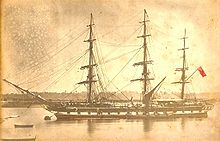Blackwall frigate
This articleneeds additional citations forverification.(October 2018) |

Blackwall frigatewas the colloquial name for a type of three-mastedfull-rigged shipbuilt between the late 1830s and the mid-1870s.
They were originally intended as replacements for the BritishEast Indiamanin the trade between England, theCape of Good Hope,India and China. From the 1850s, the frigates were also employed in the trade between England, Australia and New Zealand.[1]
The first Blackwall frigates were designed and built by Wigram and Green atBlackwall Yardon theRiver Thames.Under different owners these yards had builtEast Indiamensince the early 17th century as well as warships for theRoyal Navy.
Whereas the traditional East Indiaman had double sterngalleries,the Blackwall frigate had a single gallery and was so named partly because it was superficially similar in appearance to afrigateof the Royal Navy. With only a single gallery, the hull-lines at the stern could be very fine and combined with relatively fine underwater lines at the bow, Blackwall frigates were fast sailing ships, although not as fast as theclipperships that appeared in the late 1840s. Another feature of early Blackwall frigates was a highly rounded hull at the bow above the waterline, such ships being referred to as "apple-cheeked". The first two Blackwall frigates, the 871-tonSeringapatamand 951-tonMadagascarlaunched in 1837, carried the names of two slightly larger Indian-built frigates in the Royal Navy, as did a number of their successors. This also appears to have been part of the inspiration for the popular terminology. The yard built warships as well as merchantmen and so some techniques and features from warship-design inevitably crept into the design of the Indiamen, leading to the similarity in appearance, a feature which probably inspired both the formal name choices, and the adoption of the informal terminology.
Over 120 Blackwall frigates were built by British and Indian yards before the last, the 1857-ton iron shipMelbourne,was built at Blackwall by the Green family in 1875. They were generally considered to be safe and comfortable ships and were employed in premium trades, but were the victims of some of the most celebrated shipwrecks of the 19th century. These included:
- Madagascar,missing betweenMelbourne, Australiaand London in 1853 with the loss of about 150 lives,
- Dalhousie,sank offBeachy Headon 13 October 1853 with the loss of about 60 passengers and crew,
- Dunbar,wrecked nearSydney Headson 20 August 1857 with the loss of 121 lives,
- Northfleet,run down and sunk by a steamer in the English Channel on 22 January 1873 with the loss of 320 lives,
- Cospatrick,destroyed by fire south of the Cape of Good Hope on 18 November 1874 with the loss of 473 lives.
A well-known example of later Blackwall frigates was theParramattaof 1866[1]and theTrue Britonof 1046 tons built in 1861. TheTrue Britonmade frequent voyages to Australia and New Zealand carrying passengers, convicts and cargo. Photographs of this vessel are on display in theState Library of Victoria.

By the 1860s the main difference between Blackwall frigates and clippers was the stern gallery (which "true clippers" never had, though many "semi-clippers" did) and the residual "tumble-home" or hull curvature such that the hull was narrower at deck level than at the waterline) which was greater in a Blackwall frigate than in a clipper or semi clipper.
Both types became superseded as passenger-carrying vessels by steamships during the 1870s and later sailing ships of the type colloquially calledwindjammerswere built for cargo carrying only.
References
[edit]- ^abTudgay, Frederick."Painting, Wool Clipper Ship Parramatta".National Museum of American History.Retrieved9 March2014.
Sources
[edit]- Lubbock, Basil(1922).The Blackwall Frigates.Glasgow: Brown, Son & Ferguson.OCLC1750387.
- Lloyd's Register of Shipping
- Lyon, David (1993).The Navy Sailing List - All the Ships of the Royal Navy built, Purchased and Captured - 1688-1860.London: Conway Maritime Press.ISBN085177864X.OCLC29977497.
External links
[edit]- National Maritime Museum catalogue entry for painting entitled "The Indiaman Seringapatam arriving home"
- National Maritime Museum catalogue entry for print entitled "The Seringapatam East Indiaman, 1000 Tons"
- National Maritime Museum catalogue entry for a hull model of The Seringapatam
- National Maritime Museum catalogue entry for painting entitled "The Blackwall frigate Owen Glendower at anchor off a coastline"
- National Maritime Museum catalogue entry for print entitled "The Owen Glendower", East Indiaman, 1000 Tons (Entering Bombay Harbour)
- National Maritime Museum catalogue entry for a hull model of The Owen Glendower
